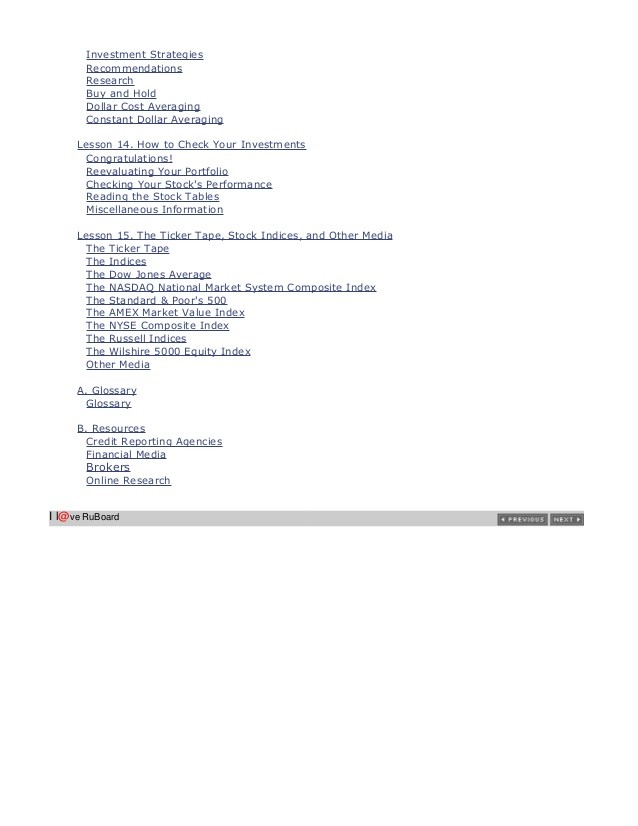Dollar Cost Averaging A Safer Investing Strategy
Post on: 11 Май, 2015 No Comment

The following is a guest post by YFS from yourfinancessimplified.com. If you want relevant, witty and easy to follow financial guidance subscribe to his newsletter by clicking here!
At this time, the US economy is at a tumble. The European debt issue is affecting the US stock market in a negative way, and the fact that unemployment is rising is not helping any. The sudden recession in 2008 also remains a fresh memory, and many stock market investors lost millions in that worldwide financial crisis. This kind of uncertainty is exactly what earns the stock market the reputation of being volatile and risky, and despite the possible large returns that you can get, many are afraid to place their hard earned cash in something that’s so unpredictable.
So is there actually a safer way that we can invest in the stock market. The answer may actually be a yes. There are techniques that can offset the risks of the ups and downs of the stock market, and one technique comes in the form of dollar cost averaging. This investment strategy has been around for years, and it is slowly gaining popularity with many financial advisors encouraging the use of this method.
What is Dollar Cost Averaging?
Simply put, dollar cost averaging is a technique wherein there is a systematic purchase of securities at a set amount, in predetermined intervals. It means that whether the stock is high or low, the investor will keep on buying the same stock, with the same amount of money, at set intervals such as every month, every quarter, and so on. This type of investing is designed to reduce market risk because in the long run, the average price that you bought the stocks will be essentially lower.
How Does It Work?
Let’s say you have $15,000 you want to invest in X stock. Instead of using it all as a lump sum you can divide it into parts such as $1,250 invested every quarter for a total of three years.
Let’s say the price of X stock in January of year 1 is $46.29 per share, then that means your $1,250 would be able to buy 27 shares of X stock. By July of the same year, the market crashed and X stock is now only worth $16.66 per share, at this price, your same amount of money would be able to buy 75 shares of the same stock. As you may have noticed, the cheaper the price of the stock will be, the more shares you can buy. This brings the average price of the stocks you bought much lower than if you just bought it all at a lump sum at the month of January.
Now the question is, what about if you just bought all the stocks at the month of July when the price was cheapest? Although it is quite possible to buy stocks when they are at the lowest price, the problem lies in predicting when will reach the bottom price. Even the most seasoned financial analysts cannot predict when a stock will hit its bottom price. The trick in dollar cost averaging is that the investor will no longer keep searching for rock low prices, but will offset the ups and downs of the market by buying slowly every month. In the long run, this technique will result in bigger returns for the investor.
How Safe Is it?
Although it is impossible to say that your money will be safe in this type of investing, the dollar cost averaging method also trains investors to think of the long term. Should the economy take a dip, this only means that share prices are low, putting more cheap shares into your portfolio that can be sold at a higher price in the future. Despite the market having its bad days or even years, the trend is that the prices of stock will eventually go up over time. During the past century, US equities markets appreciated every year by a near 11% in average according to an article from Forbes .
Again, when you employ the dollar cost averaging method, this means you can buy more shares at low prices, and it also lessens the risk of investing a large amount of money at the wrong time when the prices are high.

Criticisms to Dollar Cost Averaging
One of the obvious criticisms against the dollar cost averaging method is the fact that every small transaction will result in more fees for the investor. Some even go as far as saying that the building amount of fees will offset the possible earnings of the stock. Although this is true, some investors will opt to invest either quarterly or semi-annually to minimize fees or utilize a no fee brokerage to place trades.
Another criticism is also the lessened earning potential if the prices are low. Others would say that it would be best to buy at a lump sum at the lowest price, but again there really is no telling when the prices will reach the bottom, and it may be a tedious process for many busy investors to keep watching the market. But, If you could time the market you would be rich beyond measure.
Conclusion
The good thing about dollar cost averaging is the mere affordability of it. The investor will not need to have a large lump sum of money, and can slowly invest small sums that will eventually add up. One of the good points about it is that it provides investors with an easy and affordable way to invest money in a regular basis, without having fears, speculations and even regrets about buying at the “right” price. For those who don’t have the time and financial knowledge to keep watching the market, the dollar cost averaging method provides an avenue for investors to grow their money while maintaining peace of mind that their small purchases will offset any loses should the market retain its volatile nature.
Crystals Comments: We sort of dollar cost average. We invest $300 a month into the same mutual fund for one of our Roth IRAs all year. We invest the remaining $1400 contribution whenever we have the money on hand. My husband also buy individual stocks throughout the year with about $250 a month plus our dividends with Scottrade.














